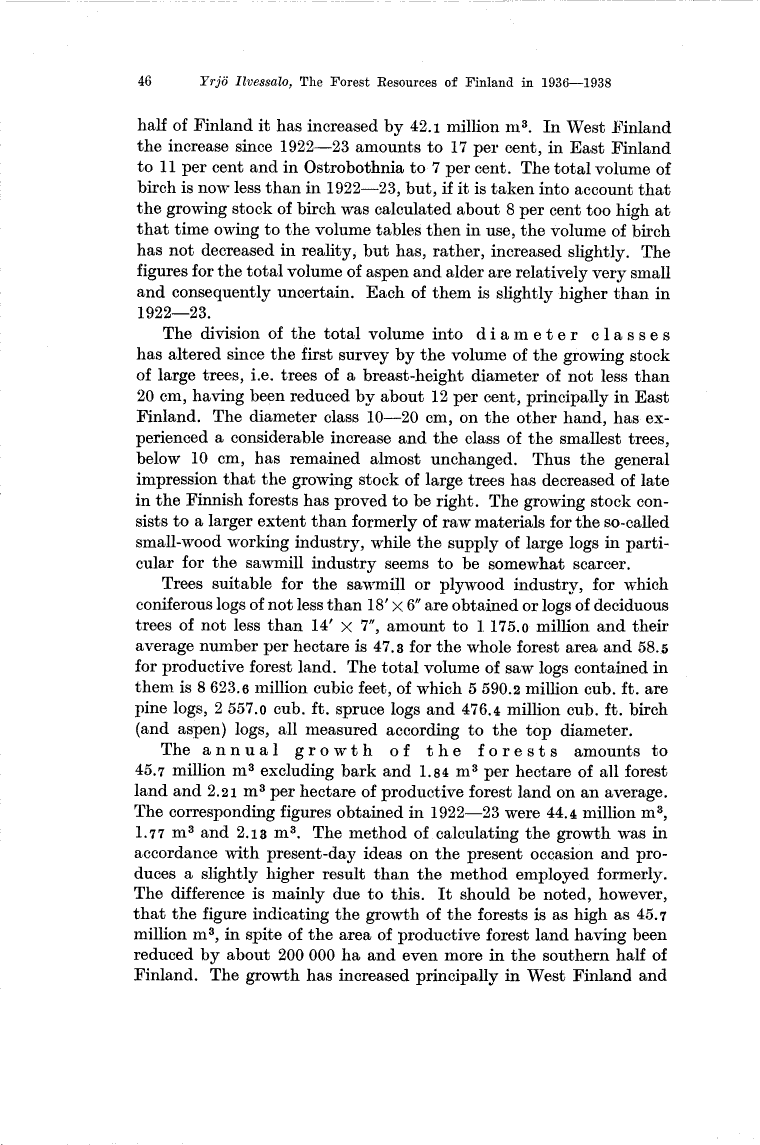
Full resolution (TIFF) - On this page / på denna sida - N:o 5 - Pages ...

<< prev. page << föreg. sida << >> nästa sida >> next page >>
Below is the raw OCR text
from the above scanned image.
Do you see an error? Proofread the page now!
Här nedan syns maskintolkade texten från faksimilbilden ovan.
Ser du något fel? Korrekturläs sidan nu!
This page has never been proofread. / Denna sida har aldrig korrekturlästs.
46 Yrjö Ilvessalo, The Forest .’Resources’ of Finland in 1936—1938
half of Finland it has increased by 42. i million m3. In West Finland
the increase since 1922—23 amounts to 17 per cent, in East Finland
to 11 per cent and in Ostrobothnia to 7 per cent. The total volume of
birch is now less than in 1922—23, but, if it is taken into account that
the growing stock of birch was calculated about 8 per cent too high at
that time owing to the volume tables then in use, the volume of birch
has not decreased in reality, but has, rather, increased slightly. The
figures for the total volume of aspen and alder are relatively very small
and consequently uncertain. Each of them is slightly higher than in
1922—23.
The division of the total volume into diameter classes
has altered since the first survey by the volume of the growing stock
of large trees, i.e. trees of a breast-height diameter of not less than
20 cm, having been reduced by about 12 per cent, principally in East
Finland. The diameter class 10—20 cm, on the other hand, has
experienced a considerable increase and the class of the smallest trees,
below 10 cm, has remained almost unchanged. Thus the general
impression that the growing stock of large trees has decreased of late
in the Finnish forests has proved to be right. The growing stock
consists to a larger extent than formerly of raw materials for the so-called
small-wood working industry, while the supply of large logs in
particular for the sawmill industry seems to be somewhat scarcer.
Trees suitable for the sawmill or plywood industry, for which
coniferous logs of not less than 18’ x 6" are obtained or logs of deciduous
trees of not less than 14’ x 7", amount to 1 175.0 million and their
average number per hectare is 47.3 for the whole forest area and 58.5
for productive forest land. The total volume of saw logs contained in
them is 8 623.6 million cubic feet, of which 5 590.2 million cub. ft. are
pine logs, 2 557.0 cub. ft. spruce logs and 476.4 million cub. ft. birch
(and aspen) logs, all measured according to the top diameter.
The annual growth of the forests amounts to
45.7 million m3 excluding bark and 1.84 m3 per hectare of all forest
land and 2.21 m3 per hectare of productive forest land on an average.
The corresponding figures obtained in 1922—23 were 44.4 million m3,
1.77 m3 and 2.13 m3. The method of calculating the growth was in
accordance with present-day ideas on the present occasion and
produces a slightly higher result than the method employed formerly.
The difference is mainly due to this. It should be noted, however,
that the figure indicating the growth of the forests is as high as 45.7
million m3, in spite of the area of productive forest land having been
reduced by about 200 000 ha and even more in the southern half of
Finland. The growth has increased principally in West Finland and
<< prev. page << föreg. sida << >> nästa sida >> next page >>